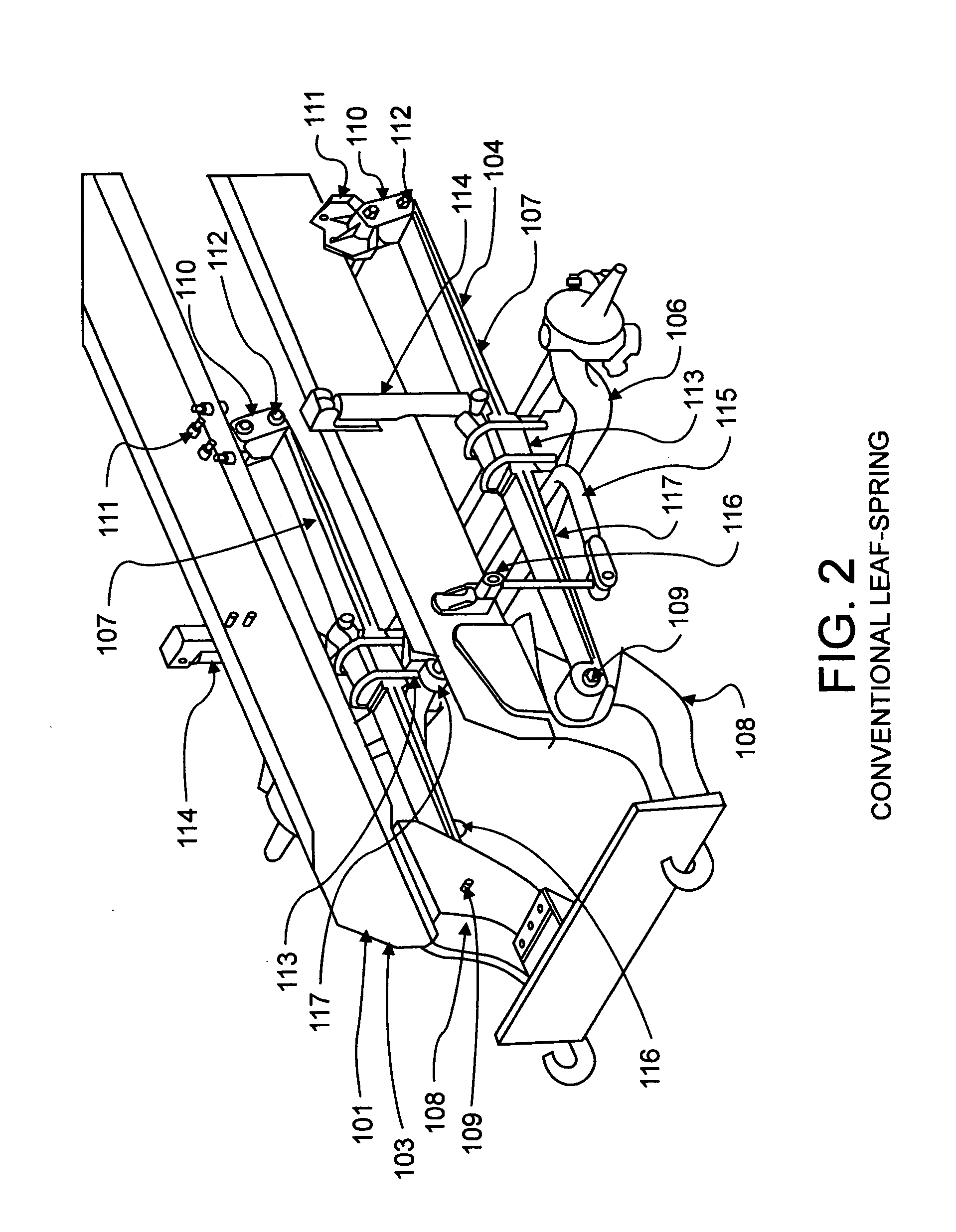[0002] Ground-traveling vehicles are generally provided with suspension elements to absorb shocks to the vehicle resulting from unevenness of the ground and the
forward velocity of the vehicle. As is well-known in the art, these suspension elements include some type of spring, some type of damping element, and either a full or partial axle. The simplest type of vehicle suspension, and still commonly used in heavy-duty vehicles, is the double
leaf spring and
solid axle arrangement. This type of vehicle suspension has many positive attributes. It is robust and simple to manufacture. It is vertically compliant and laterally rigid, yet capable of carrying heavy vehicle loads. However, unmodified it is also yields unacceptably to vehicle body roll.
[0007] The increase in the axle torsion subcomponent of auxiliary roll stiffness can be visualized as follows. As the vehicle leans, the outer spring is compressed to a greater extent, and the inner spring is relieved to some extent, as mentioned previously. As a leaf spring is compressed, it generally flattens in the case of a parabolic spring, or becomes invertedly parabolic in the case of a flat spring. It also changes in distance between the spring eyes, which explains the need for the spring
shackle mentioned previously. At some point at or near its mid-point, a tangent drawn to the spring at that point remains at a fairly
constant angle relative to the longitudinal axis of the vehicle throughout deflection of the spring. Forward and rearward of that theoretical midpoint, the angle between a tangent drawn to the spring and the longitudinal axis of the vehicle will change throughout deflection of the spring. By attaching the axle to a point other than that theoretical midpoint, generally in the direction from the theoretical midpoint toward the direct connection between the spring and the
vehicle frame via the spring hanger, torsion is introduced to the axle, due to the fact that the inner and outer springs are deflecting in opposite directions resulting in opposite changes in the angularity between the tangents drawn to the springs and the longitudinal axis of the vehicle. By also increasing the
torsional rigidity of the axle, the axle torsion subcomponent of auxiliary roll stiffness is increased.
[0008] Remembering that these subcomponents together have previously contributed to an approximate increase in auxiliary roll stiffness of only ten percent when longitudinal
asymmetry has been increased previous to the invention disclosed herein, attempts have been made to further increase the contribution of both subcomponents of the auxiliary roll stiffness component, leaf twist and axle torsion, by thickening a half-portion of the leaf spring overall length. Typically, the half-portion of the overall length of the leaf spring toward the direct connection between it and the
vehicle frame via the spring hanger has been made thicker, so that the half-portion of the leaf spring toward the spring
shackle was required to accommodate a greater degree of deflection. This increased the polar
moment of inertia of the thicker half-portion of the leaf spring, thereby increasing the leaf twist subcomponent of the auxiliary roll stiffness component. Thickening the half-portion of the leaf spring also forced the angle between the tangent drawn to the spring at the point where the axle is attached and the longitudinal axis of the vehicle to change to a greater degree during deflection. The resulting increase in torsion of the axle increased the axle torsion subcomponent of the auxiliary roll stiffness component of overall roll stiffness.
[0010] The invention disclosed herein allows for an increased level of roll stiffness by increasing the auxiliary roll stiffness component via the use of a thick truncated half-leaf, while alleviating a corresponding increase in leaf stress via the use of an opposing thinner truncated half-leaf. This is accomplished by constructing a leaf spring
assembly comprised of a first upper thick truncated half-leaf nearest the direct connection between the spring assembly and the
vehicle frame via the spring hanger, a second full length thinner leaf, and a third lower truncated half-leaf of sufficient thickness to generate the desired
vertical stiffness, located opposite the first upper thick truncated half-leaf. The upper thick truncated half-leaf gives the increased polar
moment of inertia required for increasing the leaf twist subcomponent of the auxiliary roll stiffness component, and forces the angle between the tangent drawn to the spring at the point where the axle is attached and the longitudinal axis of the vehicle to change to a greater degree during deflection, thereby increasing the axle torsion subcomponent of the auxiliary roll stiffness component when used with a torsionally rigid axle. The second full length leaf provides
vertical stiffness and structural redundancy via the front eye wrap at the direct connection to the vehicle frame via the spring hanger and the rear eye wrap at the spring
shackle connection. The third lower truncated half-leaf allows for tuning of the
vertical stiffness while minimizing leaf stresses in itself and the second full length leaf.
[0012] There are many advantages to utilizing a suspension having spring assemblies of this type. The suspension may be tuned more aggressively, having a relatively low vertical spring rate overall, while maintaining high roll stiffness. It exhibits typical
jounce and rebound travel, due to control of spring stress to within normal limits. Furthermore, it is economical to implement, as the spring assembly is compatible with conventional spring mounting and axle attachments. There is a reduced need for a stabilizer bar, allowing for the possible
elimination of the stabilizer bar and attachments altogether.
 Login to View More
Login to View More  Login to View More
Login to View More 


